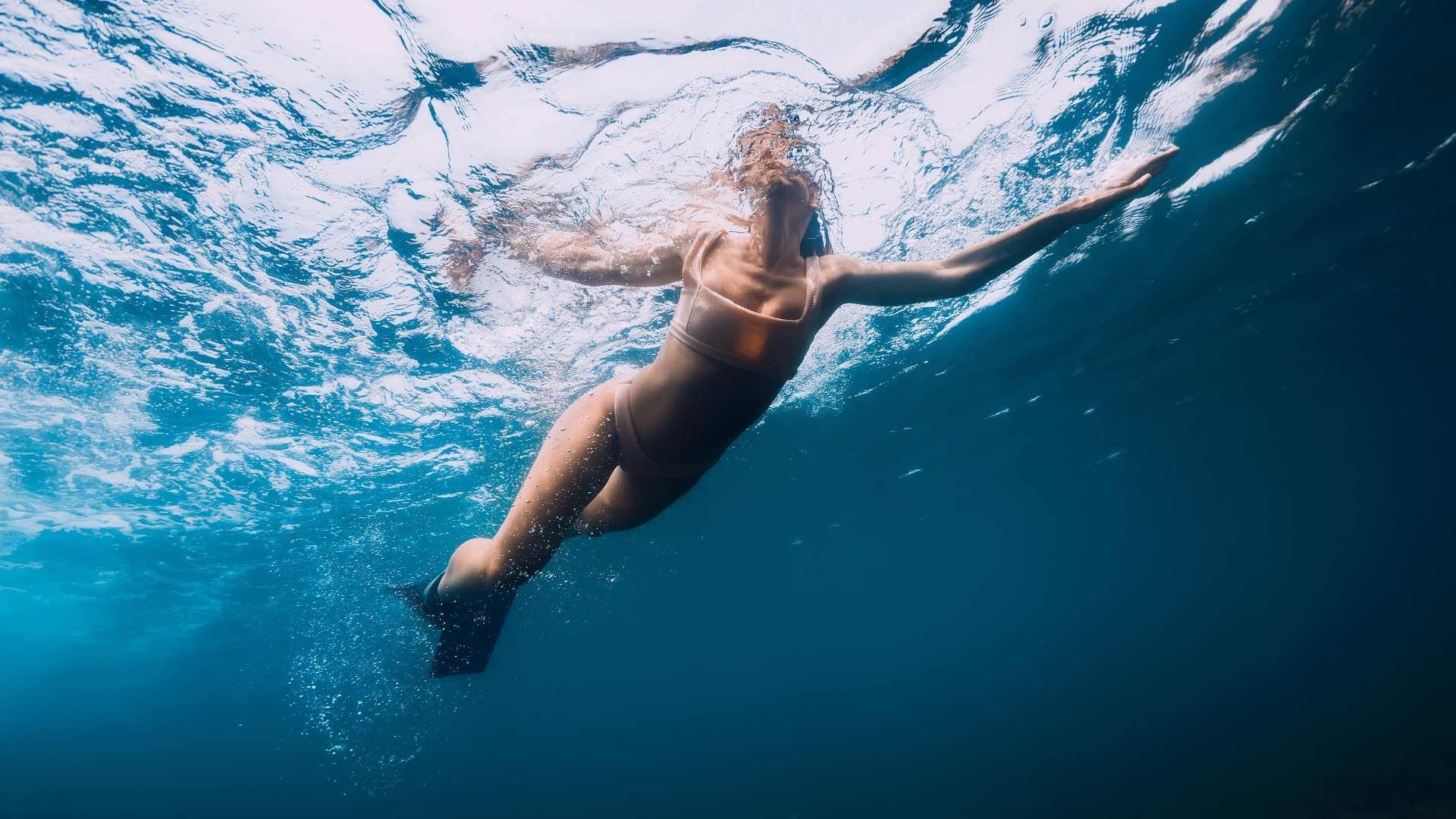
Is it safe to swim in the ocean during your period?
Swimming in the ocean during your period is generally safe. Menstrual blood doesn't attract sharks or increase your risk of infection. With proper hygiene and the right protection, you can enjoy beach activities throughout your cycle.
Quick links:
What to expect when swimming during your period
Types of period products for ocean swimming
Tips for comfort and confidence
We’ll cover the facts about ocean swimming during menstruation and provide practical tips for a comfortable experience.
What to expect when swimming during your period
Ocean swimming during menstruation poses no inherent health risks. The saltwater doesn't increase your chances of infection. Contrary to popular myths, menstrual blood doesn't attract sharks.
Your period flow continues in water, though it may slow because of water pressure. This temporary effect doesn't replace the need for period products. Tampons, menstrual cups, or specialized period swimwear offer the best protection while swimming.
Water activities might actually reduce period pain for some women. The buoyancy and coolness of ocean water can provide relief from menstrual cramps. If you experience severe cramps or heavy flows, you may want to avoid swimming for your own comfort.
Risks and precautions for swimming on your period
Although safe, swimming in the ocean while on your period comes with some minor risks you’ll want to manage.
- Infection: Ocean water contains bacteria. While your vagina has natural defenses, prolonged exposure might increase the chance of vaginal infections. Rinse off after swimming and promptly change into dry clothes.
- Leakage: Water makes some period products less effective. Check and change your protection more frequently than usual.
- Cramps: Cold water might worsen menstrual cramps for some women. If you're prone to severe cramps, you may want to avoid swimming on your heaviest days.
- Toxic shock syndrome (TSS): While rare, the risk of TSS increases if you leave a tampon in for too long. Change tampons regularly, even if your flow seems lighter in water.
Note: everyone's body is different. Pay attention to how you feel and adjust your swimming habits accordingly.
Hygiene tips for swimming during menstruation
Ocean swimming during your period requires specific hygiene practices. Here's what to keep in mind:
- Always use a fresh tampon, menstrual cup, or period swimwear before entering the ocean.
- Rinse off with fresh water after leaving the ocean to remove salt and sand.
- Change your period product immediately after swimming.
- Avoid sitting in a wet swimsuit for long periods.
- Be aware that ocean water may temporarily reduce your flow due to water pressure.
- Pack extra period products for beach trips in case of leaks or heavy period flow.
Menstrual products for ocean swimming
There are several period products you can try when you want to go for a swim in the ocean and keep your menstrual blood flow in check. Let’s learn more about them so you can decide which one is right for you.
Tampons
Tampons are one of the best options for swimming during your period. When inserted, tampons expand inside the vagina to absorb menstrual blood before it exits the body.
Choose higher-absorbency tampons for swimming. Bring extras to change every few hours. Wash your hands before you remove your tampon. Replace them often to reduce infection risk and prevent leaks.
Tampons do a great job of stopping flow, but they also have some downsides. Read more about swimming on your period without a tampon.
Menstrual cups
Reusable menstrual cups collect (rather than absorb) period blood. They are made from medical-grade silicone, rubber, or thermoplastic elastomer (TPE). You use menstrual cups by inserting them into the vagina to catch and contain flow.
For swimming, look for cups with a firm, wide rim. Practice insertion at home first and follow cleaning instructions. Empty it every 2–4 hours.
Period pads
Reusable cloth pads with a built-in absorbent liner are a good option for those women who prefer wearing a pad. Look for pads that securely adhere to the inner crotch of your bikini bottoms or swim shorts to prevent shifting and leaks. Our women’s high-waist bikini bottoms are great for this.
Change pads every 2–3 hours as you would normally to prevent overflow and maintain freshness. Rinse externally with fresh water after swimming to keep clean and dry.
Check out our article on swimming on your period with a pad.
Menstrual discs
Menstrual discs are a reusable option for managing period flow while swimming. The smooth, flexible disc is inserted into the vagina to sit around the cervix. It collects menstrual blood before it exits the body.
Discs adapt to your body shape, staying secure during swimming motions. They also hold more blood than cups.
Look for discs made from medical-grade silicone or plastic and pick the correct size for your body. Empty it every 12 hours. Loop your finger under the pull tab for mess-free removal, even in public restrooms.
Leak-proof swimwear
If you are not into internal period products such as a tampon or cups, you can try leak-proof swimsuits and swim bottoms.
This period-friendly swimwear has a hidden-layer liner or absorbent gusset sewn into the crotch to catch any blood or leaks from your pad. This saves you from needing to wear an extra pair of tight shorts underneath.
Nothing
Some women don’t do anything while swimming during their menstrual cycle. While many women worry about leaks or infections, practitioners rely on water pressure to reduce menstrual flow and claim it works.
Tips for comfort and confidence
Want to keep swimming through your menstrual cycle? Here are some handy tips to make your ocean experience more carefree:
- Stay hydrated
- Use heat therapy
- Pack emergency supplies
- Rinse off after swimming
- Moisturize
- Choose the right swimwear
Stay hydrated
Drink plenty of water before, during, and after your swim. Dehydration can make cramps and fatigue worse, so keep a water bottle handy. Skip caffeine and alcohol—they'll only dehydrate you more.
Use heat therapy
If cramps hit while you're at the beach, take a break and apply something warm to your lower abdomen. A hot water bottle or heat pack wrapped in a towel can work wonders.
Pack emergency supplies
Bring extra tampons, pads, and clean underwear. You'll be glad to have backups if your flow is heavier than expected or you need a quick change.
Rinse off after swimming
Take a quick shower after your ocean swim. It'll wash away salt, sand, and any menstrual fluid, keeping you fresh and helping prevent infections.
Moisturize
Saltwater can be drying, especially for sensitive skin. After your shower, apply a gentle, hypoallergenic moisturizer to keep your skin happy.
Choose the right swimwear
Dark-colored swimsuits are your best friends during your period. They're less likely to show stains if you have any leaks. Look for quick-dry swimsuit materials and styles that can securely hold a pad in place if needed.
Popular period myths
You've probably heard some wild stories about swimming in the ocean during your period. Let's set the record straight on these common myths.
Myth 1: Sharks will attack you
Reality: Sharks aren't attracted to menstrual blood. There's no scientific evidence that being on your period increases your risk of a shark attack. So go ahead and enjoy your ocean swim without fear.
Myth 2: You'll leave a trail of blood in the water
Reality: The amount of blood lost during menstruation is quite small, especially when diluted in a vast ocean. It's unlikely that anyone would notice anything in the water.
Myth 3: Swimming will stop your flow
Reality: While water pressure might temporarily slow your flow, it doesn't stop completely. You might still leak without protection and your period will continue as normal once you're out of the water.
Myth 4: Your period products will fall out in the water
Reality: Properly inserted tampons or menstrual cups are designed to stay in place, even while swimming. If you're worried, try swimwear with extra coverage for added peace of mind.
Your period doesn't have to hold you back from enjoying the beach. With the right knowledge and preparation, you can swim in the ocean any time of the month!
Choose SwimZip swimwear for comfort
SwimZip offers swimwear with active comfort in mind. Our durable, quick-dry fabrics and secure coverage make our women’s swim bottoms a great choice for swimming during your period.
Pair our stylish, functional, and affordable swimwear with your preferred hygiene products for extra protection.
Beyond comfort, our swimwear protects from dangerous UV rays. As one of the most trusted UPF 50+ brands, SwimZip keeps you and your loved ones safe from the sun's harmful effects.
We have something for every family member, including swim trunks for men, swimwear for women, sunsuits for kids, sun hats, rash guards, and accessories.
Period swimming FAQ
Can I swim in the ocean during my period without a tampon?
You can swim in the ocean during your period without a tampon. Many women opt for menstrual cups or period swimwear, which offer leak protection and comfort. If you choose to swim without protection, be aware that some blood may still flow into the water, though it will be quickly diluted.
Are hormonal contraceptive pills good for painful period cramps?
Hormonal contraceptive pills often reduce painful period cramps. These pills work by thinning the uterine lining and regulating hormone levels, which typically results in lighter flow and less severe cramps.
While effective for many, hormonal contraceptives may have side effects, and not everyone experiences the same benefits. Discuss your options with a healthcare provider.
Can you go snorkeling on your period?
You can go snorkeling on your period. Use a tampon, menstrual cup, or period swimwear for protection. These options for swimming during your period will prevent leakage and keep you comfortable during your underwater adventure.
Can I swim in the sea without period protection?
Swimming in the sea without period protection is possible, but it comes with risks. You may experience some leakage, which could stain your swimwear or attract unwanted attention. The saltwater might irritate your sensitive areas. For comfort and peace of mind, using some form of period protection is recommended when swimming in the sea.
Will period blood show in the swimming pool?
It is highly unlikely that period blood will show in the swimming pool. When using a tampon or menstrual cup, any menstrual period blood is typically contained and would not be released into the water. Even if a small amount of blood were to come out, it would be diluted by the pool water and filtered out.
Chlorine in swimming pools prevents the spread of disease, so swimming during your period is not unhygienic and does not pose any potential health risk to others.
How do competitive swimmers manage their periods during heavy-flow days?
Competitive swimmers often rely on tampons or menstrual cups for protection during heavy-flow days. These products provide reliable leak prevention without impeding performance. Some athletes also use birth control to regulate their cycles, timing competitions with lighter flow days.
What exercises in water are beneficial during menstruation?
Water-based exercises beneficial during menstruation include gentle swimming, water aerobics, and aqua jogging. These low-impact activities in public pools or other bodies of water can alleviate unpleasant cramping and improve circulation. The buoyancy of water reduces stress on joints while providing resistance for an effective workout.
How can I reduce my painful menstrual cramps?
Several activities can help with menstrual cramps. Regular exercise reduces menstrual pain and discomfort. Recommended activities include:
- Aerobic exercise: brisk walking, jogging, or cycling for 30 minutes a day.
- Swimming sessions: gentle swimming laps or water aerobics in a pool or ocean.
- Light exercises: yoga, stretching, or pilates to improve flexibility and relax muscles.
- Abdominal strengthening: core workouts to support and tone the pelvic area.
- Deep breathing techniques: controlled breathing exercises to relax the body.
- Warm compresses: applying heat or a warm towel to the lower abdomen to soothe cramping muscles.





Leave a comment
This site is protected by hCaptcha and the hCaptcha Privacy Policy and Terms of Service apply.